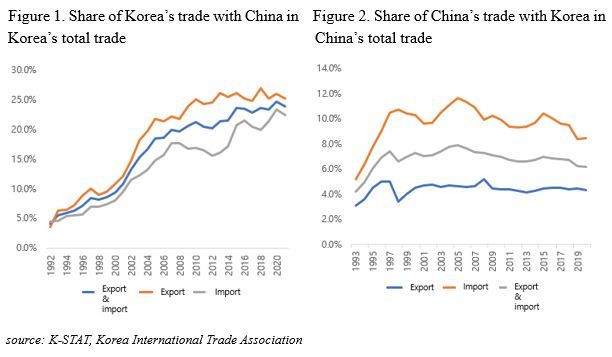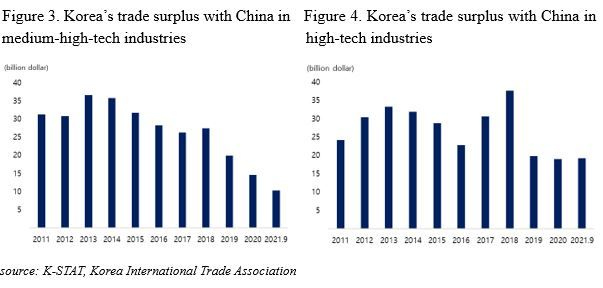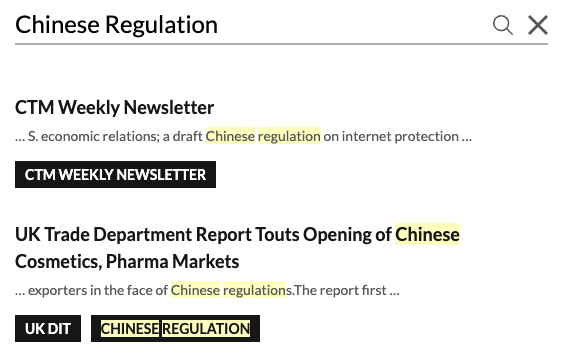This is a guest post by Kyounghwa Kim of the Korea International Trade Association (KITA). It summarizes a longer KITA report by Bo-Hee Jun and Ui-Yoon Jo.
The Korea International Trade Association (KITA) published a paper entitled “30 years of Diplomatic Relations between Korea and China: Changes in Trade Structure and Its Implication” on December 6. It reviews how trade between the two countries has been developed for the past three decades and analyzes how Korea and China compete in specific industries and the global market. The report also pointed out Korea’s heavy reliance on China in importing raw materials.
Since Korea and China established diplomatic relations in 1992, they have achieved remarkable mutual development in many areas, especially in trade. Trade volume between Korea and China was only $6.4 billion in 1992, but it increased 38 times to $241.5 billion in 2020. Especially for Korea, China has remained the largest trading partner in both import and export since 2004, occupying 24.6% of Korea’s total trade with the world in 2020, as shown in Figure 1. Although there seems to be a relatively modest increase in trade with Korea from the Chinese side (see Figure 2), Korea had emerged in 2013 as the largest exporter to China. In 2020, it was ranked as the third largest exporter to China after Japan and Taiwan.

Behind such growth in trade lies the structural interdependence between the two countries. In other words, Korea’s major industries were able to develop by providing China with high value-added core intermediate goods on the basis of its comparative advantage, and at the same time, this appears to have helped China successfully achieve its plan to shift its industrial structure toward a more high-tech orientation. Now, the trade relationship is arguably changing from interdependent to more competitive, especially in high-tech industries.
China has produced a host of industrial policies that focused on scientific and technical innovations to convert into a tech power since the early 2010s. Although the share of manufacturing in the Chinese economy has continued to decline, mainly generated by supply-side structural reforms, the portion of the high-tech industry in manufacturing has increased. Specifically, China has increasingly replaced imports with domestic production for high value-added items in the electronic display and petrochemical industries.
Changes in the Chinese industrial structure have led the trade between Korea and China to be more inclined to high-tech or medium-high-tech industries, less to medium-low-tech or low-tech industries. (Here, the categorization of industries was based on ISIC REV. 3 “Technology Intensity Definition” prepared by the OECD.) According to the analysis, Korea has increasingly exported high-tech items, marking 45% of Korea’s total export to China in 2020. Apart from the increased export volume of high-tech items, Korea's trade surplus with China in the high-tech industry and medium-high-tech industry has decreased by $5.2 billion and $16.8 billion from 2011 to 2020, respectively.

Based on the TSI (Trade Specialization Index) analysis, the report explains that while Korea had a ‘relative competitive advantage’ in bilateral trade in medium-high-tech and high-tech industries, it has now changed to being ‘in competition with’ China in those industries. Specifically, Korea’s TSI of chemical, general machines, and electric equipment, included in the medium-high-tech industry, all decreased, implying more fierce competition with China in those areas. The competition in the high-tech sector has been intensified, especially for items associated with aerospace, medical, optical, and precision equipment.
The TSI analysis also shows that the competition between Korea and China in regards to medium-high-tech or high-tech industries took place in the global market too. While the competition had been intensified in the United States between 2011 and 2018, since then, Korea and China have continued to compete in the ASEAN market. From 2011 to 2018, China’s export of medium-high-tech items to the US had increased by 7.6% on average annually, 2.3% higher than that of Korea. From 2018 to 2020, Korea’s export of medium-high-tech items to ASEAN decreased by 11.8% on average, but China’s increased 7.7% on average.
The report lastly points out that Korea has heavily relied on China to procure raw materials essential for Korean major manufacturing industries. Based on data from January to September 2021, Korea imported 94.7% of tungsten oxide from China – required for producing semiconductors. The heavy reliance on China holds for other industries such as batteries, petrochemicals, and automobiles. Korea imported 83.5% of lithium hydroxide for battery, 64.1% of ethyl acetate for petrochemical, and 100% of magnesium ingot for auto parts from China.
The author, Bo-Hee Jun, emphasized that “it is crucial for Korea to establish trade strategy in response to China’s increasing localization of intermediate goods and its own technological development, and it should be followed by expanding pool of technical experts and strengthening the technology security.” She also advised that it was necessary to focus on increasing export of final goods, including consumer goods, rather than to focus on exporting specific intermediate goods.

